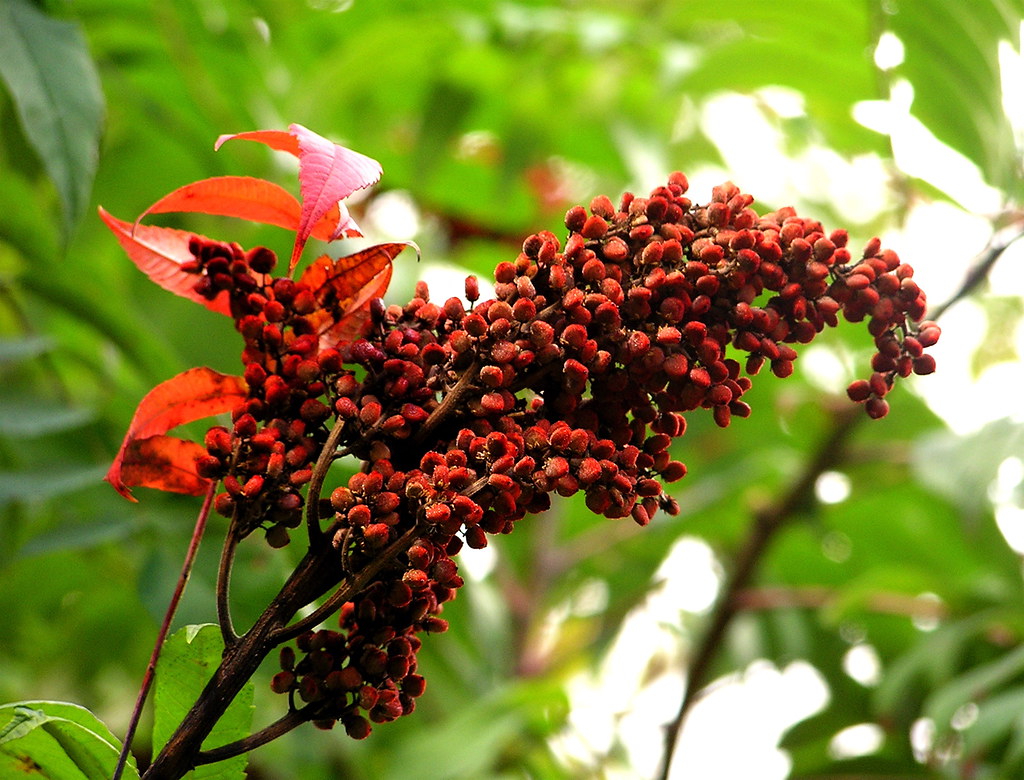Disclaimer: This Materia Medica is provided for informational purposes only and should not replace professional medical advice. Please consult with a qualified healthcare practitioner or herbalist before using any herbal remedies.
Botanical Description:
- Family: Anacardiaceae
- Genus: Rhus
- Common Names: Sumac, Staghorn Sumac, Smooth Sumac, Fragrant Sumac, Sugar Sumac
- Species: Various species within the Rhus genus, including Rhus typhina, Rhus glabra, Rhus aromatica, and others.
- Habitat: Native to North America, Sumac can be found in open woodlands, along roadsides, and in fields. It thrives in a variety of soil types and is often considered a pioneer species.
- Parts Used: Berries, leaves, and sometimes the bark.
Traditional Uses:
Sumac has a long history of traditional use among Native American, Indigenous, and traditional herbal medicine systems. These uses include:
- Culinary Delight: Sumac berries are well-known for their use as a spice in Middle Eastern cuisine. The berries are dried and ground into a tangy, lemony-flavored spice called “sumac.” It adds a unique citrusy flavor to dishes.
- Digestive Aid: Infusions or teas made from Sumac berries were traditionally used to aid digestion and soothe upset stomachs. The tannins in Sumac can help alleviate diarrhea.
- Anti-Inflammatory: Sumac has been used topically as a poultice or in baths to ease skin irritations and reduce inflammation.
- Astringent: Due to its high tannin content, Sumac was used as an astringent to help tone and tighten tissues. It was applied topically to wounds and mucous membrane irritations.
- Beverage: Native American tribes have made a refreshing beverage by steeping Sumac berries in water, similar to a lemonade. This drink is rich in vitamin C and antioxidants.
Modern Applications:
Contemporary herbalists and researchers have explored additional potential uses for Sumac, including:
- Antioxidant Properties: Sumac is rich in antioxidants, particularly anthocyanins and flavonoids. These compounds may help protect cells from oxidative stress.
- Anti-Inflammatory Effects: Sumac has demonstrated anti-inflammatory properties, which may be useful in managing conditions associated with inflammation.
- Gastrointestinal Support: Some herbalists recommend Sumac as a natural remedy for diarrhea, indigestion, and gastritis, although more research is needed to establish its efficacy.
Preparation and Dosage:
- Sumac Spice: To use Sumac as a spice, simply sprinkle the ground berries on salads, rice, grilled meats, or roasted vegetables.
- Sumac Tea: To make Sumac tea, steep 1-2 teaspoons of dried Sumac berries in hot water for 5-10 minutes. Sweeten with honey if desired. Drink up to 3 cups a day.
- Topical Application: For skin conditions, prepare a decoction or poultice using Sumac leaves or berries. Apply to the affected area as needed.
Potential Side Effects and Contraindications:
- Allergic Reactions: Some individuals may be allergic to Sumac. If you experience any signs of allergy, such as itching, swelling, or difficulty breathing, discontinue use immediately and seek medical attention.
- Pregnancy and Lactation: Pregnant and breastfeeding individuals should exercise caution when using Sumac as its safety during these periods has not been established.
- Interactions: Sumac may interact with certain medications. Consult with a healthcare professional, especially if you are taking medications for blood clotting or have a history of kidney stones.
Conclusion:
Sumac, with its rich history of traditional use and emerging research on its health benefits, is a versatile botanical. Whether used as a spice in culinary creations or as a natural remedy for digestive complaints and skin irritations, Sumac has a place in the herbalist’s toolkit. However, as with any herbal remedy, it’s essential to approach its use with knowledge, caution, and respect for individual differences and potential contraindications. Always consult a qualified herbalist or healthcare provider for personalized guidance.





